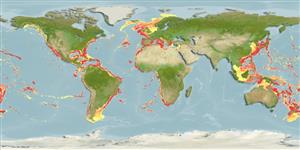Common names from other countries
Environment: milieu / climate zone / depth range / distribution range
Écologie
Pélagique; profondeur 0 - 1600 m (Ref. 116114). Tropical
Distribution
Pays | Zones FAO | Écosystèmes | Occurrences | Introductions
Indo-Pacific, Atlantic Ocean, and the Mediterranean.
Length at first maturity / Taille / Poids / Âge
Maturity: Lm ? range ? - ? cm Max length : 9.0 cm WD mâle / non sexé; (Ref. 2376)
Description synthétique
Morphologie
Up to 6.5 cm wide; nematocyst warts on exumbrella very variable in size and number. Color very variable.
Neritic, estuarine, potentially pathogenic (Ref. 116114). A holoplanktonic, oceanic and semi-cosmopolitan species (Ref. 19) inhabiting offshore warm waters (Ref. 813); non symbiotic but often appears in high numbers (Ref. 7694). Feeds on salps, doliolids, larvaceans, hydromedusae, ctenophores, chaetognaths, planktonic crustaceans and fish eggs (Ref. 2376).
Life cycle and mating behavior
Maturité | Reproduction | Frai | Œufs | Fécondité | Larves
Members of the class Scyphozoa are gonochoric. Life cycle: Egg is laid by the adult medusa which later develops into a free-living planula, then to a scyphistoma to a strobila, and lastly to a free-living young medusa.
Migotto, A.E., A.C. Marques, A.C. Morandini and F.L. da Silveira. 2002. (Ref. 813)
Statut dans la liste rouge de l'IUCN (Ref. 130435)
statut CITES (Ref. 108899)
Not Evaluated
Not Evaluated
Utilisations par l'homme
| FishSource |
Outils
Sources Internet
Estimates based on models
Preferred temperature
(Ref.
115969): 3.1 - 12.5, mean 7.1 (based on 1107 cells).
Vulnérabilité
Low vulnerability (10 of 100).
Catégorie de prix
Unknown.
